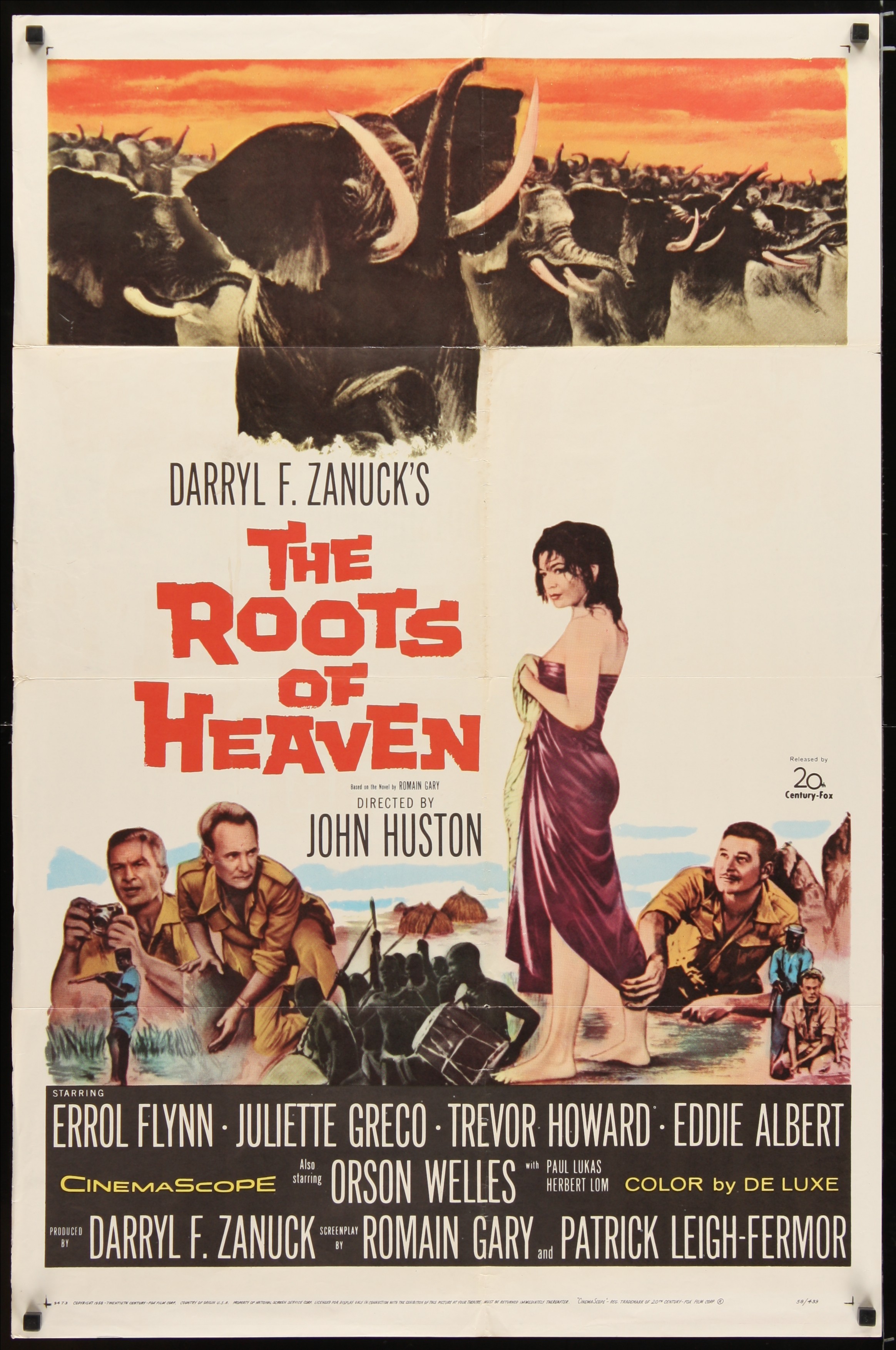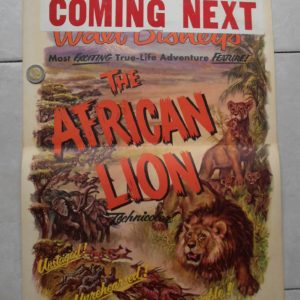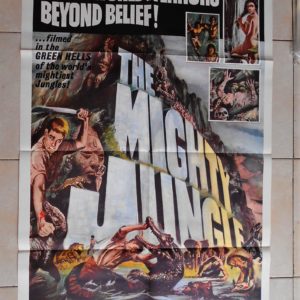Description
Original 1958 US 1 sheet, used, folded (69 x 104 cm)
The Roots of Heaven is a 1958 American adventure film in CinemaScope and DeLuxe Color made for 20th Century Fox, directed by John Huston and produced by Darryl F. Zanuck. The screenplay by Romain Gary and Patrick Leigh Fermor is based on Romain Gary’s 1956 Prix Goncourt winning novel The Roots of Heaven (Les racines du ciel).
The film starred Errol Flynn, Juliette Gréco, Trevor Howard, Eddie Albert, Orson Welles, Paul Lukas, Herbert Lom and Gregoire Aslan. The film itself was shot on location in French Equatorial Africa.
Huston later said Roots of Heaven “could have been a very fine film. And largely owing to me was not a good film at all.”
Plot
Set in French Equatorial Africa, the film tells the story of Morel (Trevor Howard), a crusading environmentalist who sets out to preserve the elephants from extinction as a lasting symbol of freedom for all humanity. He is helped by Minna (Juliette Gréco), a nightclub hostess, and Forsythe (Errol Flynn), a disgraced British military officer hoping to redeem himself.
Cast
Errol Flynn as Maj. Forsythe
Juliette Gréco as Minna
Trevor Howard as Morel
Eddie Albert as Abe Fields
Orson Welles as Cy Sedgewick
Paul Lukas as Saint Denis
Herbert Lom as Orsini
Gregoire Aslan as Habib
André Luguet as Governor
Edric Connor as Waitari
Oliver Hussenot as The Baron
Pierre Dudan as Maj. Scholscher
Marc Doelnitz as De Vries
Dan Jackson as Madjumba
Maurice Cannon as Haas
Jacques Marin as Cerisot
Alain Saury as A.D.C.
Francis de Wolff as Father Fargue
Frederick Ledebur as Peer Qvist
Jacqueline Fogt as Madam Orsini (spanked)
Production
Development
20th Century Fox bought the film rights the novel in April 1957 for a price of more than $100,000. In May, Darryl F. Zanuck announced he would produce the film independently for Fox (he had a contract with the studio to make films for them), and wanted John Huston to direct. (This was before the novel had even been published in the US, but it had already sold over 300,000 copies in Europe). Zanuck said the theme of the film was “simple… A man comes to the conclusion that if we don’t stop killing people we destroy ourselves.” And he says, “Why not start with our biggest companions on earth, the elephants, whose only enemy is man?” He later added:
This picture is really great for us – intellectually great. Whether it’s commercially great, whether people will grab on to it, we must wait and see. If they grab on to a man in love with a bridge, then why shouldn’t they grab on to a man in love with an elephant?
Huston said he wanted to direct the novel before Zanuck approached him:
After my experience with Selznick [on A Farewell to Arms] – all those memorandum! – I’d sworn never to work with a producer again, but I did want very much to make this particular film. So we met several times and talked it through and finally agreed to try it.
Huston agreed to direct for a fee he described as “slightly higher” than $300,000. Regarding the irony of a big game hunter like Huston making a movie about a militant elephant conservationist, Huston said “Contrary to prevailing opinion, I never found an elephant big enough to justify the sin of killing one.” Zanuck headed to the Belgian Congo in late 1957 to scout locations, and Gary was hired to write the script.
Casting
William Holden was mentioned as a possibility for the lead part of Morel, as was James Mason. Holden wanted to make the film but he was under contract to Paramount, who would not let him make the film unless he signed another contract with them, which he refused to do.
The lead role was taken by Trevor Howard. Errol Flynn signed to play a key support role but was given top billing. Flynn left the cast of the play The Master of Thornfield to appear in the movie. (Flynn and John Huston had famously brawled at a Hollywood party over a decade earlier.)
Juliette Greco, who had been in Zanuck’s version of The Sun Also Rises and since become the producer’s lover, was signed as the female lead. Eddie Albert and Paul Lukas rounded out the main cast. Orson Welles signed to do a cameo.
The book was eventually published in the US and became a best seller.
Shooting
The film was mostly made on location in Africa over five months, in the Belgian Congo and Chad in the Northern Cameroons, where the elephants were located. The cast and crew suffered from the heat, malaria and other tropical diseases. Temperatures would routinely reach 134 degrees in the day and 95 degrees at night; people had to shower four or five times a night. On some days it would be a four-hour drive to the location and back and all the water had to be flown in.
It is the memories of the challenging location that Flynn mentions with affection in his memoirs My Wicked, Wicked Ways (1959). The company reported 900 sick calls from a cast and crew of 120 – however Flynn did not fall ill. Juliette Greco contracted a serious illness.
“I would never make a picture there again,” said Zanuck of Africa. However he was proud that “There is not one dubbed line, transparency plate or process shot in the whole picture.”
The unit then moved to Paris for studio filming. While there, Greco fell ill with a re-occurrence of her illness. Errol Flynn had a re-occurrence of his malaria, requiring hospitalisation as well.
Orson Welles did his part in two days at a Paris studio. His rate was normally $15,000 but he did it gratis in order to repay Zanuck for helping Welles find the funds to complete the movie Othello (1952).
Huston later said, “I still don’t want to have to work with a producer again but if I had to, I’d certainly choose Darryl. He’s been very good, co-operative and decent throughout.”
Post-production
The movie was edited in London rather than Paris so that Zanuck could be near Greco, who was making a movie there.
Reception
Box office
The film earned rentals of $3 million in the United States and Canada[3] and recorded admissions of 1,266,452 in France.
Critical
The Los Angeles Times thought that “John Huston may have bitten off more than he could chew in “The Roots of Heaven,” but much of it makes for thoughtful mastication… it sometimes seems too strange to be real.”




